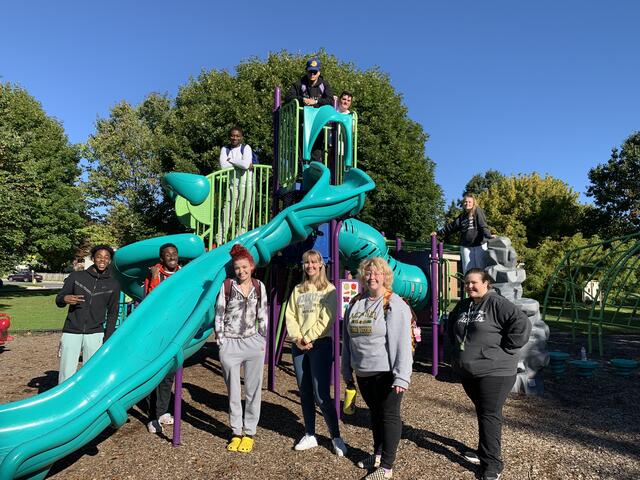Professor Stephanie Madsen on researching imaginary athletes, the psychology of play
Stephanie Madsen, professor of Psychology, published a study on the phenomenon of imaginary athletes, inspired by her class The Power of Play. In this Q&A, Madsen shares how psychology and play intersect, plus how she teaches students to make real-world connections.

Professor of Psychology Stephanie Madsen recently published a study on the phenomenon of imaginary athletes, inspired by her class The Power of Play.
In February, Professor of Psychology Stephanie Madsen published research titled “Imaginary athletes: Prevalence, forms, and developmental functions” in the journal Social Development. Co-authored with Tracy Gleason of Wellesley College, the study identifies how and when children create imagined athletes while playing sports.
Madsen’s study is the first time imagined athletes have been academically studied. Madsen and Gleason found that 40.9% of the sample, primarily men, remembered creating imaginary athletes in middle childhood (six to 12 years old). The study suggests imaginary athletes support child development in three distinct ways: as placeholders to facilitate games, athletic tools to compete against, and for companionship while playing alone.
The idea for the study was born in Madsen’s course The Power of Play, and McDaniel students also played a part in the research process. Here, Madsen shares how this study challenges expectations for imaginary figures, as well as how she makes Psychology engaging, bridges creativity and science, and teaches her students to “give psychology away.”
What first inspired your research on imaginary athletes?
When I was teaching my First Year Seminar, The Power of Play, we covered diverse topics like imaginary companions and youth sports. My students described how they used imagined beings in their athletic play and their examples were so interesting! They described ghost runners, of course, but also imaginary goalkeepers and shooting baskets against imagined NBA players.
What fascinates you about imaginary athletes?
In our study, nearly 41% of participants reported playing with an imaginary athlete and almost all these memories happened during middle childhood. We often think of imaginary beings as the stuff of preschool, but this shows a way that children continue to recruit their imagination as they get older to help them manage challenges.
"We often think of imaginary beings as the stuff of preschool, but this shows a way that children continue to recruit their imagination as they get older to help them manage challenges."
Madsen's 2021 First Year Seminar course, The Power of Play, included a visit to a playground to see structures that encourage play.
How were McDaniel students involved in the research process?
McDaniel students were involved in planning the study, submitting it to the Institutional Review Board for approval, collecting the data, developing our coding system, assisting with the coding, and reviewing drafts of the manuscript.
I am especially grateful to Julia Dunn ’21, a Psychology major who devoted a January Term to assisting with developing the coding system and coding open responses.
Your study applied to sports and play. How can psychology help us explore the world in new ways?
Psychology is the study of human thought and behavior, so there are a million applications!
Is engaging with research a core part of your courses?
Psychology classes are grounded in the research of our field and so we talk about research studies a lot. Students who are interested in getting a closer look at the research process join a lab group that meets outside of class.
How do you make psychology concepts real and concrete for your students?
I use a lot of examples in my Psychology classes, and I ask students to share examples, too. In my Developmental Psychology class, we have “development applied” days where we take what we’ve been learning about and think about real-world applications. For example, after learning about cognitive development, we play board games and consider how children at different cognitive levels would interact with them. After learning about infant motor skills, I invite babies (and their parents, many of whom are McDaniel faculty, staff, and alumni) to visit our class.

Students in The Power of Play learn about the psychology of play, with topics like princess culture, recreational sports, imaginary friends, gunplay, and cutting-edge research in nature-deficit disorder.
What’s your favorite topic to teach?
I love teaching about attachment theory! I’m teaching a 3000-level seminar on this topic next fall, and I can’t wait to see what new connections my students make.
Students have shared their “Giving Psychology Away” capstones at the Academic Symposium. What’s the aim for having students focus on this concept with their final projects?
George Miller, the president of the American Psychological Association in 1969, chastised the field of psychology for failing to share their research with the people who could benefit from it the most — the public. So, McDaniel capstone students are charged with learning about an area of research and then “giving psychology away.” This project allows students to practice the skills they have been building throughout their coursework and use it for good. This semester students will be focusing their outreach within the McDaniel community. Their projects are on fascinating topics like the dangers of co-rumination, how students’ off-task use of technology can be disruptive to classroom learning, and the psychological benefits of expressive writing.
"McDaniel’s Psychology Department encourages students to develop a deep understanding of psychological theory and research. Students who graduate from our program have had rigorous training in analyzing data and writing about research."
You have a creative background as an artist. How has your creativity informed your scholarly life, and vice versa?
I started painting when my students asked me what I did for fun outside of school … and I had no answer! For me, painting is a form of play, and I wondered if other artists felt the same way. I interviewed artists at an artist residency at the Chateau d’Orquevaux in France and found it so fascinating to see where their ideas converged and diverged from psychological theory regarding the role of play in art and creativity. My students and I developed a coding system to analyze those interviews and presented our findings at the Academic Symposium in spring 2024.
Students in Madsen's The Power of Play course in 2012.
What do you hope students take away from your Psychology classes?
I know that students won’t remember every detail of what they learn, but I hope they learn to think clearly, to examine the evidence, to challenge assumptions, and use what they learn to make informed decisions.
From your perspective, how does McDaniel’s Psychology Department best prepare students for their futures?
McDaniel’s Psychology Department encourages students to develop a deep understanding of psychological theory and research. Students who graduate from our program have had rigorous training in analyzing data and writing about research; most students have completed an internship under our supervision. The beauty of psychology is that these skills are relevant whether students continue in the field or decide to pursue other passions.
Want to Learn More?
- Read an article in The Conversation co-authored by Stephanie Madsen and Tracy Gleason.
- Listen to Professor Madsen as she shares what inspired this research in the Academic Minute.